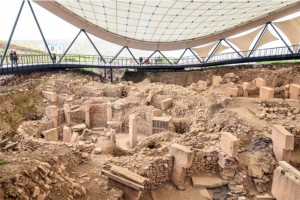Göbeklitepe Story and Its Importance
Göbeklitepe Story and Its Importance
Göbeklitepe was used as an agricultural area by local farmers until it was officially discovered. Changes have occurred in the surface area due to the farmers moving the stones in the region. There is also information that some stones were broken during this process.
The importance of Göbeklitepe primarily comes from the hunter-gatherer culture in the Stone Age, the time period when humanity transitioned to settled life, and the agricultural knowledge deeply shaken. In other words, with Göbeklitepe, the world of science has completely changed the perspective of Neolithic Age people. So much so that scientists did not think that Neolithic Age people could build such large structures.
Göbeklitepe, whose history dates back 12,000 years, is still underway. Although there is a strong possibility that the information we have now will change with new findings, the reason for the construction of Göbeklitepe remains a mystery. There is no clear evidence that Göbeklitepe, which is 8,000 years older than the pyramids and 7,000 years older than Stonehenge, was a settlement. The view that supports this is that there are no findings such as pots, utensils, garbage pits, knives, cutting tools.
There is an interesting view about Göbeklitepe that is supported by the local people. According to Mahmut Kılınç, it has become a tradition for women without children to come to this hill and pray. This tradition dates back to before the Göbeklitepe discovery.
The interesting part of the story starts at this point. There is a relief of a woman giving birth on one of the columns in Göbelitepe. The oldest known incised decoration of a woman giving birth in the world is in Göbeklitepe.
Another astonishing claim about Göbeklitepe is that this building is covered in the same way as it was made by human hands. About 1000 years after its construction, Göbeklitepe was deliberately covered with earth by human hands. This claim is strengthened by the findings that the soil layer on the ground was transplanted and corrected by man rather than naturally.
6 structures have been unearthed in Göbeklitepe so far, but there are 20 structures and 200 more obelisks in total. Contrary to the known Neolithic Age people, Göbeklitepe, which shook all the information deeply, is gaining importance day by day because an advanced architectural technique is used. There are also animal reliefs such as leopard, wild boar, scorpion, stork, fox, gazelle and snake on these columns and obelisks. These carvings became known as the earliest known 3D reliefs.
In addition, the most popular feature of Göbeklitepe is its T-shaped columns. There are no faces or expressions in these columns. However, since there are hand and finger carvings on these columns, there are theories that if this is a place of worship, the T-shaped columns portray the "god" figure. Since the hand and finger were carved, but the facial features were not, a heavenly meaning may have been attached to these pillars.
So, when was Göbeklitepe officially discovered?
Although the survey was conducted in 1963, Göbeklitepe was officially discovered in 1994 by the German archaeologist Klaus Schmidt. Before the work in 1994, in 1983, the farmer Mahmut Kılınç, who was the owner of the field in the region, came across a stone while plowing his field and took this stone to the Şanlıurfa Museum. However, the museum officials' failure to fully grasp the importance and historical place of this stone could not accelerate the work.
During the study in 1994, almost 11 years later, the true significance of Göbeklitepe was discovered. It has been determined that it covers an area with a height of 15 meters and a diameter of 300 meters in total. There are more than 200 columns in 20 different circles. Each of these pillars is 6 meters high and weighs approximately 10 tons.

